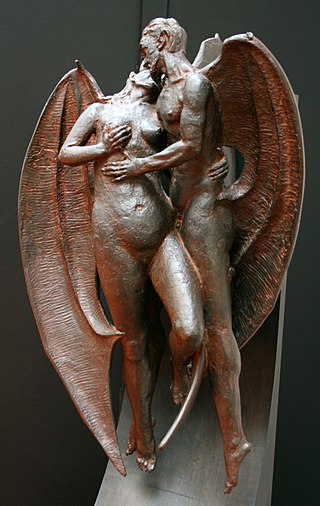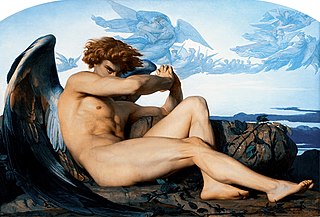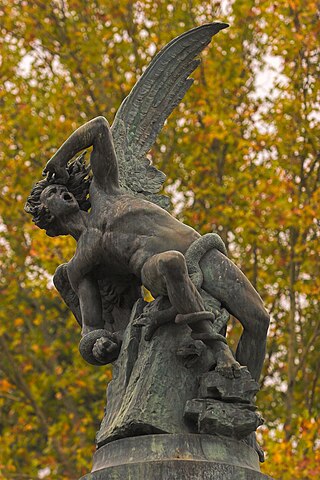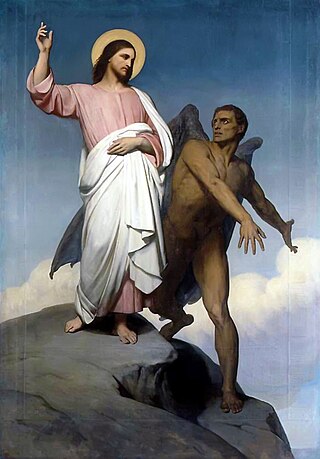
A devil is the mythical personification of evil as it is conceived in various cultures and religious traditions. It is seen as the objectification of a hostile and destructive force. Jeffrey Burton Russell states that the different conceptions of the devil can be summed up as 1) a principle of evil independent from God, 2) an aspect of God, 3) a created being turning evil or 4) a symbol of human evil.

The most common meaning for Lucifer in English is as a name for the Devil in Christian theology. He appeared in the King James Version of the Bible in Isaiah and before that in the Vulgate, not as the name of a devil but as the Latin word lucifer (uncapitalized), meaning "the morning star", "the planet Venus", or, as an adjective, "light-bringing". It is a translation of the Hebrew word הֵילֵל, hêlēl, meaning "Shining One".

Satan, also known as the Devil, is an entity in Abrahamic religions who seduces humans into sin. In Judaism, Satan is seen as an agent subservient to God, typically regarded as a metaphor for the yetzer hara, or 'evil inclination'. In Christianity and Islam, he is usually seen as a fallen angel or jinn who has rebelled against God, who nevertheless allows him temporary power over the fallen world and a host of demons. In the Quran, Iblis is an evil entity (shaitan) made of fire who was cast out of Heaven because he refused to bow before the newly created Adam and incites humans to sin by infecting their minds with waswās.

Satanism refers to a group of religious, ideological, and/or philosophical beliefs based on Satan—particularly his worship or veneration. Satan is associated with the Devil in Christianity, a fallen angel regarded as chief of the demons who tempt humans into sin. The phenomenon of Satanism shares "historical connections and family resemblances" with the Left Hand Path milieu of other occult figures such as Beelzebub, Hecate, Lilith, Lucifer, and Set. Self-identified Satanism is a relatively modern phenomenon, largely attributed to the 1966 founding of the Church of Satan by Anton LaVey in the United States—an atheistic group that does not believe in a supernatural Satan.

The Church of Satan (CoS) is a religious organization dedicated to the religion of Satanism as defined by Anton Szandor LaVey. Founded in San Francisco in 1966, by LaVey, it is considered the "oldest satanic religion in continual existence", and more importantly the most influential, inspiring "numerous imitator and breakaway groups". According to the Church, Satanism has been "codified" as "a religion and philosophy" by LaVey and his church. Founded in an era when there was much public interest in the occult, witchcraft and Satanism, the church enjoyed a heyday for several years after its founding. Celebrities attended LaVey's satanic parties and he was invited on talk shows. His Satanic Bible sold nearly a million copies.
The Satanic panic is a moral panic consisting of over 12,000 unsubstantiated cases of Satanic ritual abuse starting in the United States in the 1980s, spreading throughout many parts of the world by the late 1990s, and persisting today. The panic originated in 1980 with the publication of Michelle Remembers, a book co-written by Canadian psychiatrist Lawrence Pazder and his patient, Michelle Smith, which used the controversial and now discredited practice of recovered-memory therapy to make claims about satanic ritual abuse involving Smith. The allegations, which arose afterward throughout much of the United States, involved reports of physical and sexual abuse of people in the context of occult or Satanic rituals. Some allegations involve a conspiracy of a global Satanic cult that includes the wealthy and elite in which children are abducted or bred for human sacrifice, pornography, and prostitution.

Anton Szandor LaVey was an American author, musician, and LaVeyan Satanist. He was the founder of the Church of Satan, the philosophy of LaVeyan Satanism, and the concept of Satanism. He authored several books, including The Satanic Bible, The Satanic Rituals, The Satanic Witch, The Devil's Notebook, and Satan Speaks! In addition, he released three albums, including The Satanic Mass, Satan Takes a Holiday, and Strange Music. He played a minor on-screen role and served as technical advisor for the 1975 film The Devil's Rain and served as host and narrator for Nick Bougas' 1989 mondo film Death Scenes.

Fallen angels are angels who were expelled from Heaven. The literal term "fallen angel" does not appear in any Abrahamic religious texts, but is used to describe angels cast out of heaven or angels who sinned. Such angels often tempt humans to sin.

The Satanic Bible is a collection of essays, observations, and rituals published by Anton LaVey in 1969. It is the central religious text of LaVeyan Satanism, and is considered the foundation of its philosophy and dogma. It has been described as the most important document to influence contemporary Satanism. Though The Satanic Bible is not considered to be sacred scripture in the way that the Christian Bible is to Christianity, LaVeyan Satanists regard it as an authoritative text as it is a contemporary text that has attained for them scriptural status. It extols the virtues of exploring one's nature and instincts. Believers have been described as "atheistic Satanists" because they believe that God and Satan are not external entities, but rather projections of an individual's personality—benevolent and stabilizing forces in their life. There have been thirty printings of The Satanic Bible, selling over a million copies.
LaVeyan Satanism is the name given to the form of Satanism promoted by American occultist and author Anton LaVey (1930–1997). LaVey founded the Church of Satan (CoS) in 1966 in San Francisco. Although LaVey is thought to have had more influence with his Satanic aesthetics of "colourful" rites and "scandalous" clothes that created a "gigantic media circus", he also promoted his ideas in writings, such as the popular Satanic Bible. LaVeyan Satanism has been classified as a new religious movement and a form of Western esotericism by scholars of religion. LaVey's ideas have been said to weave together an array of sometimes "contradictory" "thinkers and tropes", combining "humanism, hedonism, aspects of pop psychology and the human potential movement", along with "a lot of showmanship", His ideas were heavily influenced by the ideas and writings of Friedrich Nietzsche, Ayn Rand and Arthur Desmond.

The temptation of Christ is a biblical narrative detailed in the gospels of Matthew, Mark, and Luke. After being baptized by John the Baptist, Jesus was tempted by the devil after 40 days and nights of fasting in the Judaean Desert. At the time, Satan came to Jesus and tried to tempt him. Jesus having refused each temptation, Satan then departed and Jesus returned to Galilee to begin his ministry. During this entire time of spiritual battle, Jesus was fasting.

The Devil, appears frequently as a character in literature and various other media, beginning in the 6th century when the Council of Constantinople officially recognized Satan as part of their belief system. In Abrahamic religions, the figure of the Devil, Satan personifies evil. In music, the Devil is referenced across both classical and popular music. Connecting the devil to certain music can be used to associate the music with immorality, either by critics or by the musicians themselves. In television and film, the Devil has a long history of being used and often appears as an extremely powerful, purely evil, antagonist. He also may appear working behind the scenes, in disguise, or in secrecy to influence a story in the forefront. In narrative works, the Devil is often associated with concepts such as the Antichrist, Hell and the afterlife, and the apocalypse. Especially in media from the early 1900s, creators might have been compelled to portray the Devil with another name or in a non-classical fashion to skirt censorship laws that discouraged showing the Devil as a character. Occasionally the Devil appears not as an entity but rather is used as a name for something that is very sinister or malevolent in a narrative such that the characters feel it is the Devil.

Theistic Satanism, otherwise referred to as traditional Satanism, religious Satanism, or spiritual Satanism, is an umbrella term for religious groups that consider Satan, the Devil, to objectively exist as a deity, supernatural entity, or spiritual being worthy of worship or reverence, whom individuals may believe in, contact, and convene with, in contrast to the atheistic archetype, metaphor, or symbol found in LaVeyan Satanism.

In Christianity, the Devil is the personification of evil. He is traditionally held to have rebelled against God in an attempt to become equal to God himself. He is said to be a fallen angel, who was expelled from Heaven at the beginning of time, before God created the material world, and is in constant opposition to God. The devil is conjectured to be several other figures in the Bible including the serpent in the Garden of Eden, Lucifer, Satan, the tempter of the Gospels, Leviathan, and the dragon in the Book of Revelation.

Hail Satan, sometimes Latinized as Ave Satanas or Ave Satana, is an exclamation used by some Satanists to invoke the name of Satan in contexts ranging from sincere expression to comedy or satire. The Satanic Temple uses the phrase as a sincere expression of rational inquiry removed from supernaturalism and archaic tradition-based superstitions.
Serpents are referred to in both the Hebrew Bible and the New Testament. The symbol of a serpent or snake played important roles in the religious traditions and cultural life of ancient Greece, Egypt, Mesopotamia, and Canaan. The serpent was a symbol of evil power and chaos from the underworld as well as a symbol of fertility, life, healing, and rebirth.

A Satanic film is a subgenre of horror film, and at times other film genres, that involves the Devil as a concept or a character. Common themes/characters in Satanic film include the Antichrist, demonic possession, exorcism, and witchcraft.

The Satanic Temple (TST) is a non-theistic organization and new religious movement, founded in 2013 and headquartered in Salem, Massachusetts. Established in reaction to the "intrusion of Christian values on American politics", congregations have also formed in Australia, Canada, Finland, Germany, and the United Kingdom. Co-founded by Lucien Greaves, the organization's spokesperson, and Malcolm Jarry, the group views Satan neither as a supernatural being, nor a symbol of evil, but instead relies on the literary Satan as a symbol representing "the eternal rebel" against arbitrary authority and social norms, or as a metaphor to promote pragmatic skepticism, rational reciprocity, personal autonomy, and curiosity.

Rising Star: The Making of Barack Obama is a 2017 biography of former President of the United States Barack Obama by American author and academic David Garrow. It is Garrow's fifth book.

Shiva Honey is a prominent figure within the modern Satanic movement, known as an artist, musician, organizer, and author. Shiva Honey has significantly contributed to the development of public rituals for The Satanic Temple (TST).















